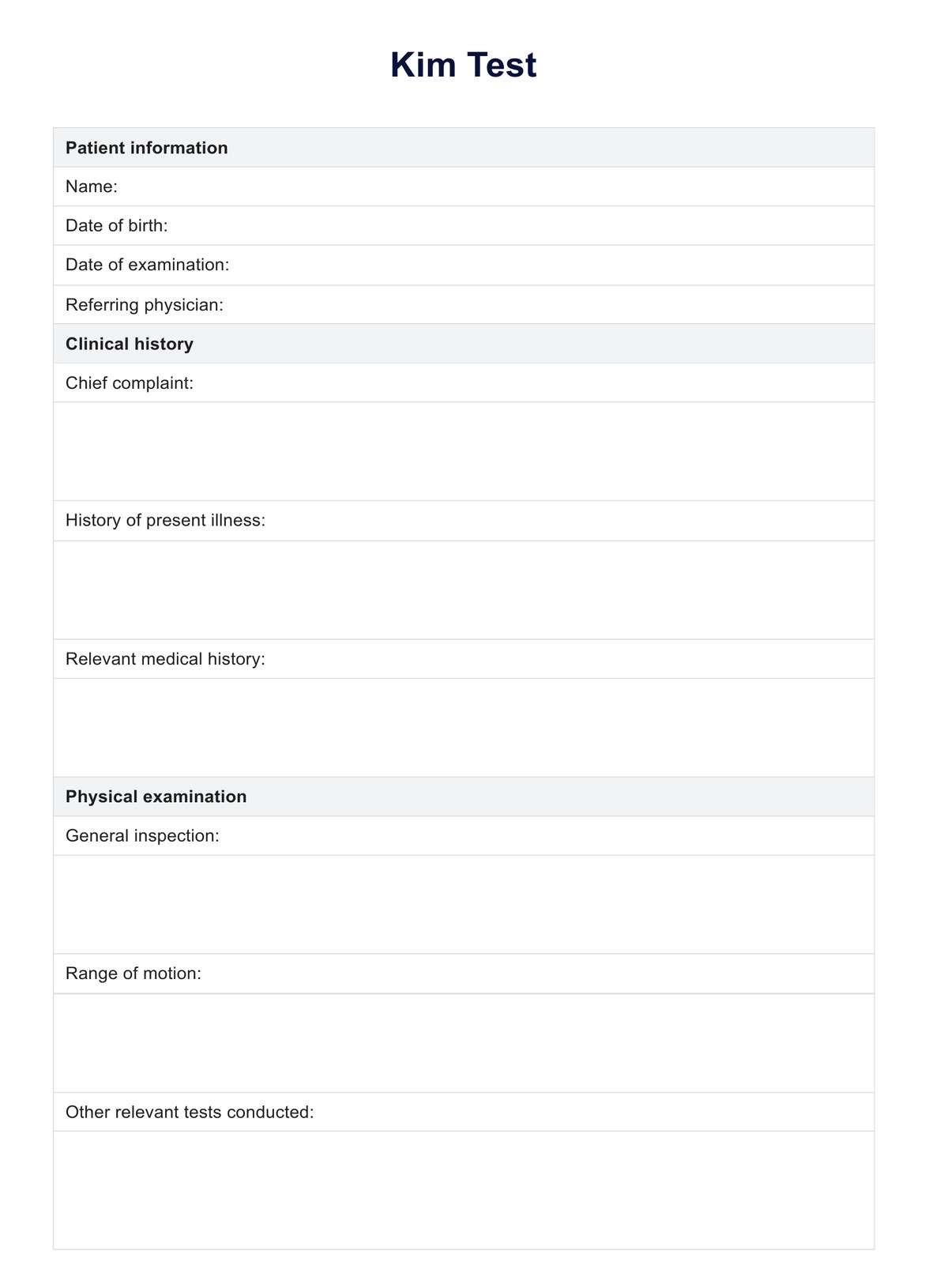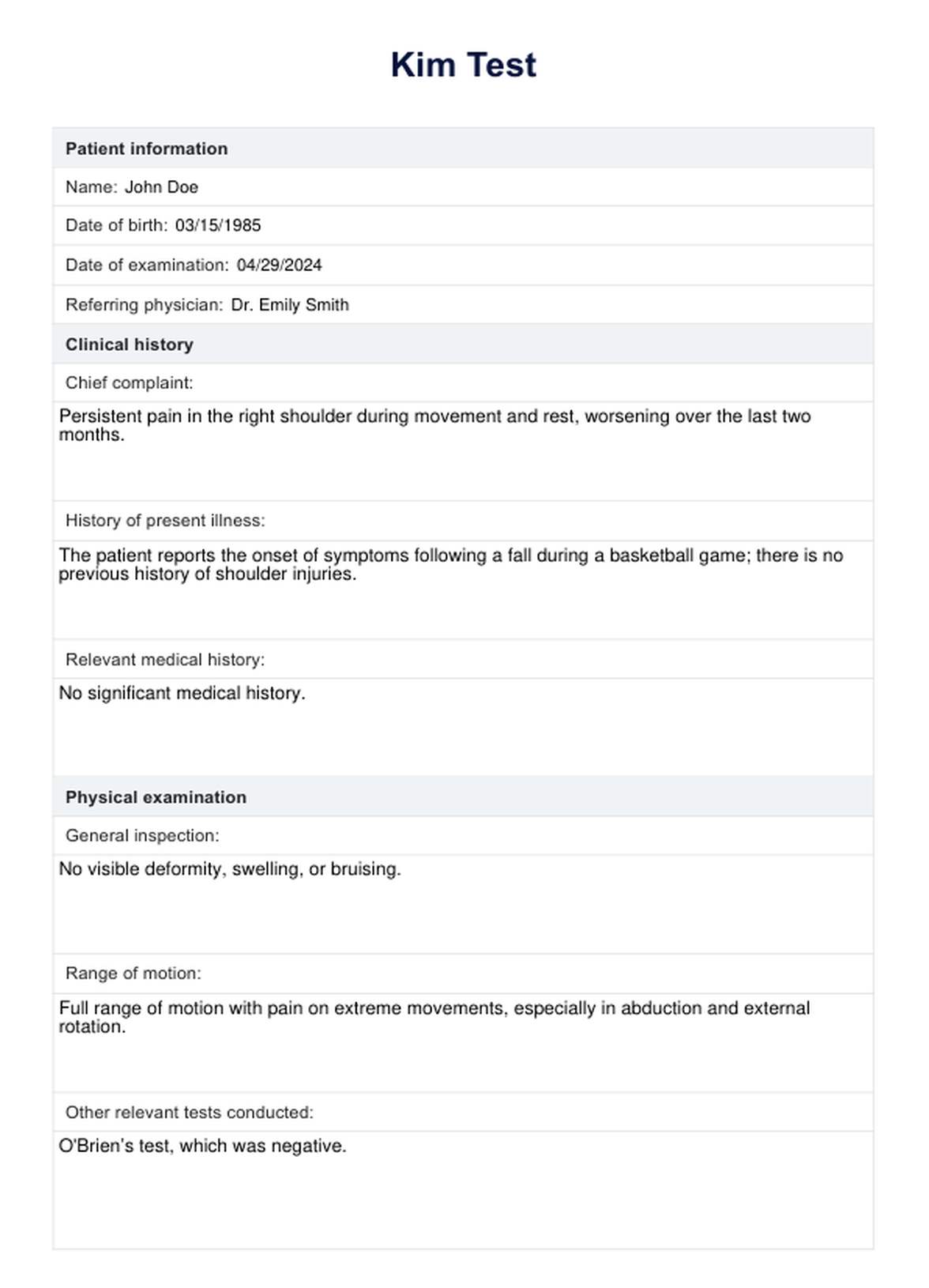Kim Test
Explore the clinical insights and expertise on the Kim Test, an essential reading for medical practitioners seeking to enhance patient care.


What is a posterior inferior labral lesion?
A posterior inferior labral lesion involves damage to the shoulder joint's posterior (back) part of the labrum. The labrum is a cartilage ring that surrounds the shoulder joint socket, helping to stabilize it and keep the ball of the upper arm bone securely within the socket.
This type of lesion is commonly caused by repetitive overhead activities, which are typical in sports like baseball or swimming, or by direct trauma to the shoulder, such as falling onto an outstretched arm. It can also occur due to a sudden pull of one hand or a forceful arm movement, especially when one hand is in an extreme position.
Symptoms of a posterior inferior labral lesion include pain in the shoulder, particularly when moving the affected arm backward or performing overhead activities. There might also be a sensation of clicking, catching, or locking in the shoulder. In some cases, the shoulder might feel unstable, and there could be a decrease in range of motion or strength in the affected arm.
Kim Test Template
Kim Test Example
How to diagnose a posteroinferior labral lesion
A healthcare provider specializing in orthopedics or sports medicine should evaluate and diagnose a posteroinferior labral lesion. They use a combination of clinical evaluation and imaging tests.
Clinical evaluation
When diagnosing a shoulder injury, the doctor asks about medical history, including any specific injuries and activities that may have led to symptoms. They will also examine the shoulder to assess pain, range of motion, and stability. The Jerk and Kim tests might provoke symptoms associated with a labral lesion.
Imaging tests
Magnetic resonance imaging (MRI) is often used to get detailed images of soft tissues, including the labrum. An MRI with a contrast agent (an MR arthrogram) can provide a clearer picture of labral tears. Healthcare professionals can also conduct a computed tomography (CT) scan to get more detail on the shoulder's bony structure, which can help diagnose if the MRI results are inconclusive.
These novel diagnostic test tools help confirm the presence of a posteroinferior labral lesion and guide the subsequent treatment options.
What is the Kim Test for the shoulder?
The Kim Test is a clinical and physical examination doctors use to diagnose specific shoulder injuries. This test helps identify posterior or posteroinferior labral tears and lesions, including a posterior labrocapsular periosteal sleeve avulsion (POLPSA) and Kim lesions. Doctors determine whether a patient has these labral tears by conducting this test.
How to conduct the Kim Test
The test is performed through these steps:
- The patient sits upright while the examiner stands behind. The examiner holds the patient's affected arm at a 90-degree angle of abduction (arm lifted sideways to shoulder level).
- The examiner elevates the arm diagonally upward and backward (obliquely) by an additional 45 degrees while simultaneously applying an axial load along the length of the humerus. The other hand of the examiner supports and stabilizes the patient's elbow.
- During this maneuver, the examiner observes any signs of pain and discomfort from the patient.
Possible results and interpretations
Here are the possible outcomes and their interpretations:
- Positive: It is positive when sudden back shoulder pain occurs during the test, which may indicate a posterior or posteroinferior labral tear. It is often accompanied by clicking or clunking sensations, suggesting posterior instability or a labral lesion.
- Negative: A negative test does not produce pain or clicking, and it suggests that there may not be a posterior labral lesion.
This new test alone, combined with other assessments and imaging, helps accurately diagnose the specific type of shoulder labral lesion, guiding appropriate management and treatment plans.
Are there any contraindications for performing the Kim Test?
There are a few considerations and potential contraindications when performing the Kim Test for diagnosing posterior labral lesions and posterior instability of the shoulder:
- Performing it on patients with severe shoulder pain or acute shoulder injuries may exacerbate their condition. Avoiding the test in these cases is advisable to prevent further damage or increased discomfort.
- Patients with limited internal rotation or other restrictions in shoulder movement might not be suitable candidates for the test.
- Individuals who have undergone shoulder surgeries around the posteroinferior labrum or the glenohumeral joint may not be ideal candidates for the Kim Test. Scar tissue and anatomy alterations could affect the test results' accuracy and reliability.
- Conditions such as severe arthritis or other inflammatory conditions affecting the shoulder joint can interfere with the test's effectiveness and the interpretation of the results.
- The test's success depends on the patient's cooperation and ability to tolerate the movements. Non-cooperative patients or those who cannot accept the test movements may yield unreliable results.
The test has shown good interexaminer reliability and is often used with other clinical tests and arthroscopic examinations for a comprehensive diagnosis. Orthopaedic surgeons performing the Kim Test should consider these contraindications and utilize their clinical judgment to determine the appropriateness of the test for each patient.
How does our Kim Test template work?
For medical professionals, the Kim Test template simplifies documenting shoulder injuries, specifically posterior or posteroinferior labral lesions. The template begins with patient information and clinical history to provide symptom context. It also includes a brief overview of physical examinations to assess shoulder health and mobility.
Here are essential steps to keep in mind as you use the template:
- Capture patient information demographics like name, date of birth, exam date, and referring physician (if applicable).
- Summarize the patient's chief complaint (e.g., pain), onset, progression, and relevant medical history.
- Note any visible shoulder abnormalities and range of motion with pain notations, and list any additional tests performed.
- Briefly describe the patient's positioning during the test. Then, record findings like pain (present/absent), location, click/clunk presence, pain severity, and the patient's reported experience. These indicate a possible labral tear and the suspected tear type (if applicable).
- Write down observations, the reasoning behind the Kim Test interpretation, or plans for further evaluation or treatment.
How should the results of the Kim Test be interpreted with other diagnostic tools?
The results of the Kim Test should be interpreted in conjunction with other reliable diagnostic test tools to ensure a reliable diagnosis. Here’s how to integrate the Kim Test results effectively:
- A positive result should prompt further investigation, often through imaging techniques such as MRI or arthroscopic examination, to confirm the presence of the lesion. The specificity and positive predictive value enhance its reliability, making it a valuable predictor of a posteroinferior labral lesion increased instability in the shoulder.
- Due to shoulder injuries, it's crucial to consider other diagnostic tests to rule out false negatives. The test's negative predictive value should be assessed in conjunction with other clinical evaluations and imaging studies to ensure a comprehensive diagnosis.
- The effectiveness should be compared with other reliable diagnostic tests for shoulder instability, such as the Jerk Test, the O'Brien Test, and MRI. Combining these tests can improve diagnostic accuracy. For instance, while the test targets posteroinferior labral lesions, other tests can identify different labral tears or shoulder pathologies.
- An arthroscopic examination may be necessary in cases where the results are inconclusive or when clinical suspicion remains high despite negative results. Arthroscopy provides a direct view of the labrum and surrounding structures, allowing for a definitive diagnosis and planning for orthopaedic surgery if needed.
- The interpretation of the results should always be contextualized with the patient's history, symptoms, and physical examination findings. For example, a patient with a history of shoulder dislocation and a positive result is more likely to have a significant labral lesion than a patient without such a history.
- In some cases, nonoperative treatment may be considered before opting for arthroscopy. The results can help guide the treatment approach by identifying patients who may benefit from physical therapy and conservative management versus those requiring surgical intervention.
What are the next steps?
After conducting the test and obtaining a positive result, you can recommend several next steps to patients. These steps involve discussing treatment options, suggesting rehabilitation exercises, and considering further diagnostic tests to confirm the diagnosis and plan a compelling and conservative treatment strategy.
- Discuss various treatment options with the patient, such as NSAIDs, muscle relaxants, or corticosteroid injections, in-depth. Recommend physical therapy, manual therapy, and heat/cold packs for relief, and advise on maintaining a healthy weight, avoiding pain triggers, and proper posture.
- Suggest rehabilitation exercises are crucial for managing the dysfunction. Core strengthening, stretching, and muscle strengthening exercises improve stability and flexibility. Low-impact aerobics like walking and swimming maintain fitness without straining the joints.
- Further tests may be needed if symptoms persist or the diagnosis is unclear. Imaging studies, diagnostic injections, and additional tests like the Fortin finger or sacroiliac compression test can help confirm the dysfunction.
- Educate the patient about their condition. Explain SIJ dysfunction, advise on modifying activities to reduce strain, and ensure they understand and can perform home exercises.
- Set regular follow-up appointments to monitor progress, adjust the treatment plan as needed, and ensure effective treatment and steady recovery.
Commonly asked questions
The Kim Test detects a posteroinferior labral lesion in the shoulder by applying specific forces to the arm and observing for posterior shoulder pain, a positive indicator.
During the Kim Test, the patient is seated with the arm at 90 degrees of abduction. The examiner applies axial loading force to the arm and then applies a downward and backward force while the arm is elevated diagonally. A sudden onset of posterior shoulder and elbow pain indicates physical examination and a positive test result.
The Kim Test is more sensitive in detecting predominantly posterior inferior labral lesions, while the jerk test detects predominantly inferior and posterior ones. Combining both tests enhances the sensitivity of this novel test for detecting posteroinferior labral lesions.







































































































